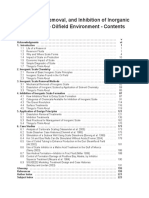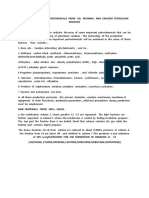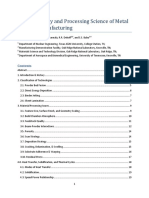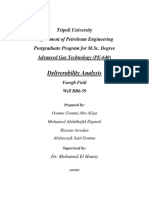0 ratings0% found this document useful (0 votes)
64 viewsFundamentals of EOR
Uploaded by
Mohamed ElkumatiCopyright
© © All Rights Reserved
Available Formats
Download as PDF or read online on Scribd
0 ratings0% found this document useful (0 votes)
64 viewsFundamentals of EOR
Uploaded by
Mohamed ElkumatiCopyright
© © All Rights Reserved
Available Formats
Download as PDF or read online on Scribd
You are on page 1/ 293
Society of
‘Petroleum Engineers
FUNDAMENTALS OF
ENHANCED OIL RECOVERY
Presented by
Dr. Larry W. Lake
©
copyright 1986
society of Petroleum Engineers
All rights reserved. This book or any part thereof
\nust not be reproduced in ary form without the
‘written permission of the Society of
Petri i
8:30
9:00
9:30
9:45
10:15
11:00
12:00
1S
1:45
215
2:30
3:30
430
Fundamentals of
Enhanced Oil Recovery
Module 1 - Defining EOR
Module 2 - Reviewing Displacement Fundamentals
Break t
Module 3 - Understanding Phase Behavior
Module 4 - Defining Polymer Flooding
Module 5 - Exploring Micellar-Polymer Flooding
Lunch
Micellar-Polymer (cont.)
Module 6 - Using Other Chemical Methods
Break
Module 7 - Analyzing Thermal Flooding
Module 8 - Acquiring Solvent Flooding Basics
Summary
First Revision
COURSE OVERVIEW
FUNDAMENTALS OF ENHANCED OIL RECOVERY
INSTRUCTOR Larry W. Lake
Department of Petroleum Engineering
The University of Texas at Austin
NEED FOR Enhanced of] recovery (EOR) 1s being used more and
COURSE more as companies recognize the need for making
the best use of existing resources, and as field
tests are proving that it is economically feasible
to use EOR methods. As the potential for gain
through EOR becomes more recognized, petroleum and
chemical engineers will be asked to evaluate the
economié and production potential of individual
wells, and to make recommendations regarding the
most ‘appropriate method. This course Is designed
to help engineers make these reconmendations.
TARGETED Chemical and petroleum engineers with at least a
AUDIENCE 8.5., experienced engineers who want to review or
to broaden their area of expertise, Individuals
who sell chemicals or services, chemists who
Understand the chemistry and want to know how it
is applied.
EXPECTED © Better understanding of why EOR is used
OUTCOMES
0 Greater awareness of the major clas:
and subdivisions of each EOR method
0 Increased ability to judge which EOR method is
appropriate for a given application
© Increased knowledge of how each EOR method works
and the problems encountered with each
CONTENT This course reviews fundamental principles of
SCOPE displacement and phase behavior needed to
understand EOR methods. It covers the four major
types of EOR, specific chemicals In each category,
conditions under which they work, and special
problems encountered with each. The course is
designed as a fundamentals course and, as such,
can only give an overview of each method.
COURSE Student time required Is approximately 18 hours,
LENGTH of which seven will be used to view the
presentations, discussions, and debriefing
activities on the video tape. Other student time
will be spent in reading workbook materials and
working fourteen exercises interspersed throughout
the course.
Intro-2
ABOUT THE INSTRUCTOR
Larry W. Lake serves on the petroleum
engineering faculty at the University
of Texas. His earlier work with Shell
Development Company led to his current
reputation as an expert in chemical
Flooding research. He holds a 8.5.
degree from Arizona State University
and a Ph.D. from Rice University, both
in chemical engineering.
‘ACKNOWLEDGEMENTS
Fred |. Stalkup, Arco Research, Plano, Texas
Gary A. Pope, University of Texas, Austin, Texas
R.S. Schechter, University of Texas, Austin, Texas
Margaret Zumr, Associates International, Inc., Dallas, Texas
Warner Klapprodt, W.K. Productions, Dallas, Texas
Mo Kudchacker, Tenneco Oi! Company, Houston, Texas
John R. Waggoner, University of Texas, Austin, Texas
Myra A. Dria, University of Texas, Austin, Texas
Intron3
COURSE OUTLINE
FUNDAMENTALS OF ENHANCED OIL RECOVERY
INTRODUCT | ON
PROCESS OVERVIEW... +005
COURSE OVERVIEW,
INSTRUCTOR INFORMATION.
COURSE OUTLINE.
COURSE MAP.....
SI CONVERSION CHART AND’! HINTS:
MODULE 1...DEFINING EOR
MODULE OVERVIEW.
OVERVIEW... 2.05
CURRENT STATUS.
WHY EOR?.....04 are
COMPARATIVE PEFORMANCES.
FORECASTS FOR EOR
SUMMARY
REFERENCES... +--++eeee
EXERCISE 1: WHY EOR?....
MODULE 2...REVIEWING DISPLACEMENT FUNDAMENTALS
MODULE OVERVIEW...-.---+
FACTORS AFFECTING OIL RECOVERY
AREAL SWEEP EFFICIENCY...
VERTICAL SWEEP EFFICIENCY
DISPLACEMENT SWEEP EFFICIENCY
SWEEP EFFICIENCY SUMMARY...
TRAPPED OIL SATURATION.
REFERENCES... eee
EXERCISE 2: CALCULATING CAPILLARY NUMBERS...
EXERCISE 3: ANALYZING FACTORS WHICH AFFECT OIL RECOVERY.
MODULE 3...UNDERSTANDING PHASE BEHAVIOR
MODULE OVERVIEW. .
OVERVIEW... Beer
PRESSURE-TEMPERATURE DIAGRAMS.
PRESSURE-COMPOSITION DIAGRAMS.
TERNARY DIAGRAMS. «
REPRESENTATIVE SAL.
SUMMARY.
REFERENCES. Meee
EXERCISE 4: SKETCHING A PRESSURE-COMPOSITION DIAGRAM. ..
EXERCISE 5: USING A TERNARY DIAGRAM.....
Intro=4
COURSE OUTLINE
FUNDAMENTALS OF ENHANCED OIL RECOVERY
MODULE 4...0EFINING POLYMER FLOODING
MODULE OVERVIEW... shel
USES/TYPES.....++ whe?
POLYMER CHEMISTRY. heb
POLYMER PROPERTIES. wheB
FIELD RESULTS... shel9
FAVORABLE CONDITIONS she 2lt
whe
whe 27
MODULE 5...EXPLORING MICELLAR-POLYMER FLOODING
MODULE OVERVIEW... seeesSel
PROCESS DEFINITION. . 5-2
SURFACTANTS...064 5-8
PHASE BEHAVIOR.. +... 5-13
INTERFACIAL TENSION... 5-19
SLUG FORMULATION. ..... 5-23
SURFACTANT RETENTION. 5-25,
LAB/FIELD RESULTS. 5-30
SUMMARY... 5-36
REFERENCES... 4. ..04 pee 5-37
EXERCISE 7: ESTIMATING OPTIMAL CONDITIONS... 5-39
EXERCISE 8: DEFINING THE IMPORTANCE OF RETENTION. 5-42
MODULE 6...USING OTHER CHEMICAL METHODS
MODULE OVERVIEW. ....206 6-1
FOAM FLOODING. 6-2
FOAM STABILITY. 6-3
CHARACTER! STICS. 265
EFFECTS. ..seeceseeeeee sane 6-6
ALKALINE FLOODING... seen 69
DISPLACEMENT MECHAN! SMS see 6913,
ROCK-FLUID INTERACTIONS 6-17
FIELD RESULTS.....-+ 6-21
SUMMARY. « « ooo 6-23
REFERENCES... +. .+00+ eeceeee 6-24
EXERCISE 9: SUMMARIZING ALKALINE AND FOAM FLOODING. 6-27
Intro-5
COURSE OUTLINE
FUNDAMENTALS OF ENHANCED OIL RECOVERY
MODULE 7..-ANALYZING THERMAL FLOODING
MODULE OVERVIEW.
VISCOSITY REDUCTION. .
ENTHALPY OF STEAM.
FOUR PROCESS VARIATIONS.
OTHER DISPLACEMENT MECHANI SHS.
EFFECTS OF LOW STEAM DENSITY
HEAT LOSSES..
CALCULATION PROCEDURES.
FIELD TESTS
SUMMARY. «
REFERENCES.
EXERCISE 10:
ine HOw Viscosity REDUCTION
IMPROVES PRODUCTIVITY,
EXERCISE 112 CALCULATING HEAT LOSS,
wecee eee eeeeeDnhd
MODULE 8...ACQUIRING SOLVENT FLOODING BASICS
MODULE OVERVIEW.
SOLVENT FLOODING FUNDAMENTALS.
SOLVENT PROPERTIES......
SOLVENT-CRUDE PHASE BEHAVIOR.
SOLVENT DISPLACEMENT CLASSIFICATIONS. ««.+
SOLVENT FLOODING EXPERIEMENTS
DISPLACEMENT MECHANISMS.
LABORATORY RESPONSE.
FIELO RESPONSE......
SUMMARY se eee
REFERENCES...
EXERCISE 12; USING MINIMUM MiSCIBILITY PRESSURE
CORRELATIONS, wee BOIS,
EXERCISE 13: MINIMUM MISC
GAS DRIVES. ..+seseeereeeees
EXERCISE 14: UNDERSTANDING FINGERING... «+
Intro-6
COURSE OUTLINE
FUNDAMENTALS OF ENHANCED OIL RECOVERY
SUMMARY
SOLUTION
SOLUTION
SOLUTION
SOLUTION
SOLUTION
SOLUTION
SOLUTION
SOLUTION
SOLUTION
SOLUTION
SOLUTION
SOLUTION
‘SOLUTION
SOLUTION
SCREENING GUIDES.....+4.4
GENERAL REFERENCES.
Intro-7
EXERCISE
EXERC! SE
EXERC! SE
EXERC! SE
EXERCISE
EXERCISE
EXERCISE
EXERCISE 8,
EXERCISE
EXERCISE
EXERCISE
EXERCISE
EXERCISE
EXERCISE
+ Sum=2u
++ Sum=25
+ Sum=28
COURSE MAP
ACTIVITIES IN EACH MODULE
MODULE 1
‘tape (40) Exercise (10)
HOOULE 2
Tape (38) Exercises (30)
Course Introduction
Module Overview
Presentation through
EOR Forecasts
Reading (1-1 to 1-19)
Exercise 1
Debriefing Exercise 1
Module Sunmary
Reading (2-1 to 2-16)
= Module Overview
= Presentation through
Trapped 0i1 Saturation
= Reading (2-17 to 2-20)
- Exercise 2
= Debriefing Exercise 2
= Exercise 3
= Debriefing Exercise 3
= Module Summary
= Reading (3-1 to 3-12)
MODULE 3
Tape (45) Exercises (40)
MODULE &
Tape (50) Exercises (20)
Module Overview
Presentation through
Pressure-Composition Diagrams
Exercise 4
Debriefing Exer
ek
= Module Overview
~ Presentation through
Mechanical Degradation
+ Exercise 6
= Debriefing Exercise 6
Presentation= Ternary Diagrams = Presentation through
Reading (3-13 to 3-17)
Presentation finishing
Ternary Diagrams and
Representative Salini
Exercise 5
Debriefing Exercise 5
Module Summary
Reading (4-1 to 4-13)
Favorable Conditions
= Module Summary
- Reading (5-1 to 5-12)
Tatro-8
COURSE MAP
MODULE 5 RODULE 6
Tape (76) Exercises (55) Tape (20) Exercise (15)
= Module Overview
Module Overview
= Presentation through Reading (6-1 to 6-24)
Surfactants
Exercise 9 then Debrief
= Reading (5-13 to 5-24)
Module Surmary
= Presentation through
Slug Formulation
Reading (7-1 to 7-6)
- Exercise 7 then Debrief
= Presentation on
Surfactant Retention
= Reading (5-25 to 5-36)
= Exercise 8 and Debrief
= Presentation: Lab/Field Results
= Module Summary
HOOULE 7 MODULE 8
Tape (60) Exercises (50) Tape (87) Exercises (60)
= Module Overview = Module Overview
= Presentation through = Presentation through
Steaming a Well Solvent Displacement
Classifications
= Exercise 10 then Debrief
= Exercise 12 then Debrief
= Presentation through
Heat Losses = Exercise 13 then Debrief
+ Exercise 11 then Debrief = Presentation through
Displacement echani sms
+ Module Surmary
= Reading (8-23 to 8-27)
= Reading (8-1 to 8-22)
= Exercise 14 then Debrief
= Presentation on Lab/Field
Results and Module Summary
= Course Summary
Tntro-85
In Abridged St Units Guide?
ST Base Quantities and Units
ST Unit Syrbol SPE Dirensions
("Abbreviation") Syrbol
ge Cuantity OF et tne et Use Foman
Spisension* a Wpetght) type erisht) Tee
Tage ater @
mass Kdlogram kg a
tire second : 5
thermodynamic temperature kelvin x t
amommt_ of substance: mole’ mol
2 hen the role 1s used, the elementary entities must be specitiedi they may be, atone,
then the ions, electrons, other perticles, or specified groups of such particles in
Potiole work, the tama *kilogran mole", ‘pound sole", etc., are often erroneously
Shortened to “nole*.
‘Same Comon ST Derived Units
‘st Unit Syrbol
(abbreviation) ,
Bante,
acceleration
area
density
fpergyr serk
force
preseure
feloctty we
Visconity, dyrante Pye
Viscosity, Kdneraete ah
vise. =
‘to Convert From » mutetply bv
2d
acre (0.8. survey! wees ied) 4.046 872 £002
cores Feeiee2) 41386 000 B04
stroephere (standard) feseal (ex) ‘1-013 280 E05
fr Bieca} tye) 2-000 000 £v05
Barrel (for petroleum 42 gal) Bega) geo 672 Eo
birmel fee) 5.615 5600
Beieian chemel unit. (International Table) SSalesG) 1.088 086 Esa?
earcy Hater?) 9.868 232 E13
Gay ban solar) Second ts) #840 000 0d
ane reveog fi) 1-000 000 LoS
Gilion 0.8. quid) Pecos) 3.905 412 £03
gan Elloggae, kg) 1-000 000 -03
fectare fetter) 1000 000 E+04
Bie 1.8. survey! eter ta Tens 947 even
eeu {ibm svolsepots) Rilogean tkg) 40595 924 5-01
Spool
sun km pakke
natis conestes
eat bien
ie & sah
mS
ee
Re}
oe
ei 4
ae
ais ie Geuranen of
ie 3 Oe ition ot
mo Se Eittionn oe sitianitn
1 Re As, et ale, The SI Heteic System of Units and SPE's Tenta-
Intro-9 campbell
tive metric Standard, JPr, Dec. 1977, p. 1575.
COMMON SI_UNITS
USED IN THIS COURSE
SI HINTS
km? = 1(km)? = 1(10?m)*= 1 X 108m?
1MPa = 147 psi
1K = 1.8F
1k) = 1 Btu
1 um? = 1 Darcy
1ImPa-s= 1p
1mN/m = 1 dyne/cm
Intro=10
MODULE 1
DEFINING EOR
Enhanced O11 Recovery (E0R) is oi! recovery by the Injection of
materials not normally found in the reservoir. This module Is an
overview to help you analyze the need for EOR, define the major EOR
processes, and compare the performance of each. This course
focuses on oll recovery, and does not address enhanced gas
recovery. Also be aware that only U.S. domestic statistics are
cited in this section.
OBJECTIVES: During this module you wi
1, Define EOR
2. Analyze the EOR target
3. Discuss the current status of EOR
1), Describe the need for EOR
5. Define incremental oi! recovery
6. Compare performances of chemical, thermal,
and solvent processes
7. Examine EOR forecasts
OUTLINE: 0 OVERVIEW
© CURRENT STATUS
0 WHY EOR?
© COMPARATIVE PERFORMANCES :
© FORECASTS FOR EOR
© SUMMARY
ACTIVITIES: During this first section of the course, you will
listen toa presentation and discussion, read the
reference material in the workbook, and complete an
exercise . designed to help you summarize the
formation presented.
Exercise 1: Why EOR?
MATERIALS: Video Tape Hodule 1
Workbook Pages 1-1 to 1-21
TIME: You can expect to take approximately 50 minutes to
complete all of the activities in this module in
addition to the reading.
Tape Time: 40 minutes Exercise: 10 minutes
Fundamentals of Enhanced Oi! Recovery
MODULE 1
OVERVIEW
DEFINITION Enhanced of! recovery (E0R) is defined as oil
recovery by the injection of materials not
normally present in the reservo
This definition embraces all modes of recovery processes
(drive, push-pull, and well treatments), and covers a very large
number’ of oi! recovery agents. Most importantly, the definition
does not restrict EOR to a particular phase (primary, secondary, or
tertiary) in the producing life of a reservoir. Nearly all EOR
processes have been at least field-tested as _ secondary
displacements. Conmercial primary or secondary thermal floods are
common. To be sure, much interest has been focused on tertiary EOR,
but the definition does not place any such restriction.
DISTINCTIONS The definition does exclude waterflooding and is
intended to exclude all pressure maintenance
processes. Sometimes the latter distinction is not clear since
many pressure maintenance processes have displacement character.
Moreover, agents such as methane in a high pressure gas drive or
carbon dioxide in a reservoir with substantial resident CO, do not
satisfy the definition, yet both are clearly EOR processes. Usually
the EOR cases that fall outside of the definition are classified by
the intent of the process.
1-2 Fundamentals of Enhanced Oi! Recovery
MODULE 1
OVERVIEW
EOR TARGET Much of the interest in £0R centers around the
amount of oi] to which it is potentially
applicable. Table 1 shows that this "target" oil accounts for 278
billion barrels in the domestic U.S. which represents nearly 70% of
the 401 billion barrels of original oil in place.
TABLE 1...PRODUCTION, RESERVES AND RESIDUAL OIL IN PLACE
U.S. ONSHORE, EXCLUDING ALASKA (from Geffen, 1973)
Billions Percent of
Category of Barrels Original Oi! In Place
Produced 101 25.2
Proved Reserves 22 5.
EOR Target 278 63
TOTAL yor 100.0
If EOR could recover only 10% of this amount, it could more
than double the proved domestic reserves.
1-3 Fundamentals of Enhanced Oil Recovery
MODULE 1
CURRENT STATUS
WHERE WE STAND NOW The possibility of recovering substantial
additional oil lies primarily in the future.
Recent production trends, Figure 1, show that a steadily growing percentage of
the domestic production comes from EOR processes.
FIGURE 1
EOR PRODUCTION RATE
(from Petroleum Data Book)
EOR recovery as % of domestic Production
10.0% 10.0 10.0
9.0%
8.0%
7.0%
6.0%
5.0%
4.0%
3.0%
2.0%
1.0%
0.0%
es + © aan
es s 3 8g e 8s S&S &
Oe ota ee
Fundamentals of Enhanced Oil Recovery
revised 2/96
MODULE 1
CURRENT STATUS
ACTIVITY Thermal methods, particularly steam drive and soak (combined on
ANALYSIS Table 2) occupy the larges share of EOR projects and have :
experienced steady growth between 1971 and 1986. (It has since
declined, as all activity in the oil industry has.)
PROJECTION Project number measures activity, but oll production rate
RATE measures success. Table 3 shows nominal daily oil production
rates for the EOR processes.
JOMESTIC EOR PRODUCTION RATE BY PROCESS TYPE
(from Oil and Gas Journal)
TABLE
1982 198419861988 «199019921904 1996
Thermal Methods
Steam 288.4 958.1 468.7 455.5 444.1 4540 415.8 419.4
Insitu combustion 102 64 103 65 61 47 25 4s
Hot Water 07 29 40 20 a7 03
Total thermal 298.6 364.8 479.7 464.9 454.2 460.7 419.0 424.2
Chemical
Micollarpomer 0.928 4.8 458 °
Poymer 29 102 1530288
Akane 06 03 02 0.0
Total chemical 44 18-4 16.9 22.5 11.8 22 41.9 04
Solvent
Hycrocarbon miscible 14.4 93.85.8559 118.1 99.7 98.3
C02 miscible 313° 284 643956 145.0 161.5 170.7
C02 immiscible 07 (44 04 ot on
Nitrogen 7a) 105 oO) (22.918 eae) | cat 28
Fluogas (miscibleand 298.4281 21.4173 1400 °
immisefble)
other 63 0 44 48
Total solvent 83.0 108.2 131.0 190.6 298.0 288.6 299.4
Grand total 903.0 460.9 604.7 618.4 656.6 760.9 709.5 723.7
1-6 Fundamentals of Enhnaced Oil Recovery
revised 4/96
You might also like
- Niranjan C. Nanda - Seismic Data Interpretation and Evaluation for Hydrocarbon Exploration and Production_ a Practitioner’s Guide (Advances in Oil a (2021, Springer) - Libgen.liNo ratings yetNiranjan C. Nanda - Seismic Data Interpretation and Evaluation for Hydrocarbon Exploration and Production_ a Practitioner’s Guide (Advances in Oil a (2021, Springer) - Libgen.li307 pages
- Effect of Temperature On Polymer Viscosity and Its Feasibility For Polymer FloodingNo ratings yetEffect of Temperature On Polymer Viscosity and Its Feasibility For Polymer Flooding17 pages
- Biological Importance of Carbonyls & Nitrosyls100% (1)Biological Importance of Carbonyls & Nitrosyls7 pages
- (GEOLOGY COMPUTER) GeoFrame 4.0 PetroViewPlus Petrophysical WorkflowNo ratings yet(GEOLOGY COMPUTER) GeoFrame 4.0 PetroViewPlus Petrophysical Workflow122 pages
- Qualitative and Quantitative Analysis Organic ChemistryNo ratings yetQualitative and Quantitative Analysis Organic Chemistry17 pages
- Key Elements To Revive The Mature Handil FieldNo ratings yetKey Elements To Revive The Mature Handil Field12 pages
- McCain - Heavy Components Control Reservoir Fluid BehaviorNo ratings yetMcCain - Heavy Components Control Reservoir Fluid Behavior4 pages
- Microbial Enhanced Oil Recovery-1989-gPGNo ratings yetMicrobial Enhanced Oil Recovery-1989-gPG237 pages
- Enhanced Oil Recovery-Do You Have The Right EOR Strategy?: R&D Solutions For OIL & GASNo ratings yetEnhanced Oil Recovery-Do You Have The Right EOR Strategy?: R&D Solutions For OIL & GAS12 pages
- Introduction To Reservoir Engineering: - by Dr. M PrinceNo ratings yetIntroduction To Reservoir Engineering: - by Dr. M Prince29 pages
- CY6251 Engineering Chemistry II Lecture Notes PDF100% (1)CY6251 Engineering Chemistry II Lecture Notes PDF55 pages
- In-Depth Investigation of The Validity of The Archie Equation in Carbonate RocksNo ratings yetIn-Depth Investigation of The Validity of The Archie Equation in Carbonate Rocks10 pages
- 2022REP - Module 2 - Lesson 2.5 - Enhanced Oil Recovery TechniquesNo ratings yet2022REP - Module 2 - Lesson 2.5 - Enhanced Oil Recovery Techniques55 pages
- Top 50 Topics of Chemistry for JEE Main jv7cviuv2025 - MathonGoNo ratings yetTop 50 Topics of Chemistry for JEE Main jv7cviuv2025 - MathonGo11 pages
- Lecture Notes On Petrchemicals From Refining and Cracked Petroleum ResiduesNo ratings yetLecture Notes On Petrchemicals From Refining and Cracked Petroleum Residues9 pages
- The Metallurgy and Processing Science of Metal Additive ManufacturingNo ratings yetThe Metallurgy and Processing Science of Metal Additive Manufacturing76 pages
- Curricullum of 6 Semester For Diploma in Chemical Engineering (Effective From 2020-21 Sessions)No ratings yetCurricullum of 6 Semester For Diploma in Chemical Engineering (Effective From 2020-21 Sessions)24 pages
- Integrated Reservoir Characterization Studies PDFNo ratings yetIntegrated Reservoir Characterization Studies PDF3 pages
- Van Loon, S. & Fricker, B. (2018) - Practical Determination and Application of HSP For The Paints & Coatings IndustryNo ratings yetVan Loon, S. & Fricker, B. (2018) - Practical Determination and Application of HSP For The Paints & Coatings Industry7 pages
- Larry W. Lake - Russell Johns - Bill Rossen - Fundamentals of Enhanced Oil Recovery-SPE (2014)No ratings yetLarry W. Lake - Russell Johns - Bill Rossen - Fundamentals of Enhanced Oil Recovery-SPE (2014)784 pages
- An Integrated Model For History Matching and Predicting Reservoir Performance of Gas/Condensate WellsNo ratings yetAn Integrated Model For History Matching and Predicting Reservoir Performance of Gas/Condensate Wells12 pages
- A Regression Technique With Dynamic Parameter Selection For Phase-Behavior MatchingNo ratings yetA Regression Technique With Dynamic Parameter Selection For Phase-Behavior Matching6 pages
- Comparative Study of Eight Equations of State For Predicting Hydrocarbon Volumetric Phase BehaviorNo ratings yetComparative Study of Eight Equations of State For Predicting Hydrocarbon Volumetric Phase Behavior12 pages
- Filtration Properties: Principles of Drilling Fluids 钻井液工艺原理No ratings yetFiltration Properties: Principles of Drilling Fluids 钻井液工艺原理55 pages
- A Regression Technique With Dynamic-Parameter Selection For Phase Behavior MatchingNo ratings yetA Regression Technique With Dynamic-Parameter Selection For Phase Behavior Matching8 pages
- Well Control: 1 Advanced Drilling Engineering SPRING 2015No ratings yetWell Control: 1 Advanced Drilling Engineering SPRING 201550 pages
- Enhanced Oil Recovery in Unconventional Reservoirs (Shale Oil and Gas)No ratings yetEnhanced Oil Recovery in Unconventional Reservoirs (Shale Oil and Gas)137 pages
- CO2 Gas Injecion For EOR Processes - Marwa AlageiliNo ratings yetCO2 Gas Injecion For EOR Processes - Marwa Alageili62 pages
- Niranjan C. Nanda - Seismic Data Interpretation and Evaluation for Hydrocarbon Exploration and Production_ a Practitioner’s Guide (Advances in Oil a (2021, Springer) - Libgen.liNiranjan C. Nanda - Seismic Data Interpretation and Evaluation for Hydrocarbon Exploration and Production_ a Practitioner’s Guide (Advances in Oil a (2021, Springer) - Libgen.li
- Effect of Temperature On Polymer Viscosity and Its Feasibility For Polymer FloodingEffect of Temperature On Polymer Viscosity and Its Feasibility For Polymer Flooding
- (GEOLOGY COMPUTER) GeoFrame 4.0 PetroViewPlus Petrophysical Workflow(GEOLOGY COMPUTER) GeoFrame 4.0 PetroViewPlus Petrophysical Workflow
- Qualitative and Quantitative Analysis Organic ChemistryQualitative and Quantitative Analysis Organic Chemistry
- McCain - Heavy Components Control Reservoir Fluid BehaviorMcCain - Heavy Components Control Reservoir Fluid Behavior
- Enhanced Oil Recovery-Do You Have The Right EOR Strategy?: R&D Solutions For OIL & GASEnhanced Oil Recovery-Do You Have The Right EOR Strategy?: R&D Solutions For OIL & GAS
- Introduction To Reservoir Engineering: - by Dr. M PrinceIntroduction To Reservoir Engineering: - by Dr. M Prince
- In-Depth Investigation of The Validity of The Archie Equation in Carbonate RocksIn-Depth Investigation of The Validity of The Archie Equation in Carbonate Rocks
- 2022REP - Module 2 - Lesson 2.5 - Enhanced Oil Recovery Techniques2022REP - Module 2 - Lesson 2.5 - Enhanced Oil Recovery Techniques
- Top 50 Topics of Chemistry for JEE Main jv7cviuv2025 - MathonGoTop 50 Topics of Chemistry for JEE Main jv7cviuv2025 - MathonGo
- Lecture Notes On Petrchemicals From Refining and Cracked Petroleum ResiduesLecture Notes On Petrchemicals From Refining and Cracked Petroleum Residues
- The Metallurgy and Processing Science of Metal Additive ManufacturingThe Metallurgy and Processing Science of Metal Additive Manufacturing
- Curricullum of 6 Semester For Diploma in Chemical Engineering (Effective From 2020-21 Sessions)Curricullum of 6 Semester For Diploma in Chemical Engineering (Effective From 2020-21 Sessions)
- Van Loon, S. & Fricker, B. (2018) - Practical Determination and Application of HSP For The Paints & Coatings IndustryVan Loon, S. & Fricker, B. (2018) - Practical Determination and Application of HSP For The Paints & Coatings Industry
- Larry W. Lake - Russell Johns - Bill Rossen - Fundamentals of Enhanced Oil Recovery-SPE (2014)Larry W. Lake - Russell Johns - Bill Rossen - Fundamentals of Enhanced Oil Recovery-SPE (2014)
- An Integrated Model For History Matching and Predicting Reservoir Performance of Gas/Condensate WellsAn Integrated Model For History Matching and Predicting Reservoir Performance of Gas/Condensate Wells
- A Regression Technique With Dynamic Parameter Selection For Phase-Behavior MatchingA Regression Technique With Dynamic Parameter Selection For Phase-Behavior Matching
- Comparative Study of Eight Equations of State For Predicting Hydrocarbon Volumetric Phase BehaviorComparative Study of Eight Equations of State For Predicting Hydrocarbon Volumetric Phase Behavior
- Filtration Properties: Principles of Drilling Fluids 钻井液工艺原理Filtration Properties: Principles of Drilling Fluids 钻井液工艺原理
- A Regression Technique With Dynamic-Parameter Selection For Phase Behavior MatchingA Regression Technique With Dynamic-Parameter Selection For Phase Behavior Matching
- Well Control: 1 Advanced Drilling Engineering SPRING 2015Well Control: 1 Advanced Drilling Engineering SPRING 2015
- Enhanced Oil Recovery in Unconventional Reservoirs (Shale Oil and Gas)Enhanced Oil Recovery in Unconventional Reservoirs (Shale Oil and Gas)
- CO2 Gas Injecion For EOR Processes - Marwa AlageiliCO2 Gas Injecion For EOR Processes - Marwa Alageili











































































